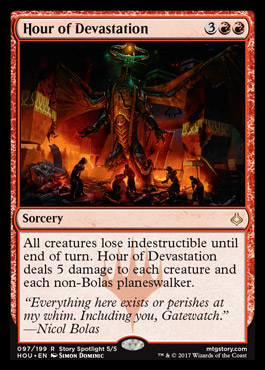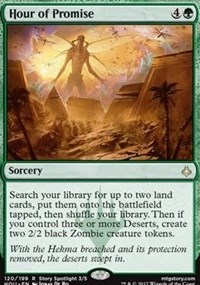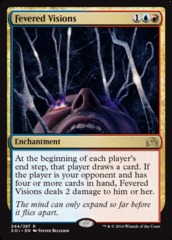In Response – Blue-Red Burn

Come one, come all! Gather round as I introduce a new article series: In Response. In this series I will be delving in to the latest metagame in the given format, with a deck that’s built to attack it.
On today’s episode we’re focusing on the week one Standard format even as it’s still settling down. As Wizards of the Coast have reduced the number of Magic Online decklists published on the mothership there is less information for everyone to work with, but if you’ve spent any time online you may have noticed a few trends:


These two are stealing the show. As Dom and I wrote about before the prerelease, these cards have caused a massive resurgence in the Blue-Red control and Green ramp decks, both of which have now worked their way towards the top of the leaderboards, at least in terms of popularity. Whether they have the raw power level to stay there once the format has settled is yet to be seen, but if you’re planning on playing standard this weekend, you’ll need to come prepared.
At first glance, one might expect both of these decks should be vulnerable to the early pressure and diverse threat package that Mardu vehicles brings to the table, but these decks have become more resilient against this through a simple innovation:

Abrade tidily cleans up a number of the format’s most aggressive creatures – Winding Constrictor, Longtusk Cub and everything Zombies can put together on the first three turns, but it’s the “Shatter” mode that proves most powerful against Vehicles. Tidying up Heart of Kiran and Scrapheap Scrounger effectively neuters early aggression, picking apart a key threat whilst also shutting down Toolcraft Exemplar, which otherwise can be responsible for upwards of six points of damage in an average game. Keeping the battlefield clear of vehicles allows Blue-Red to clean up the rest with Hour of Devastation, and without flyers Hour of Promise’s ability to spew out zombie tokens can help to buy a lot of time to get to your endgame.
What we need to attack these decks is a threat base that is resistant to the powerful instant. Enter Fevered Visions. This enchantment was the core of a successful deck during the Eldritch Moon standard season, and looks well set-up to make a resurgence against the latest competitors. Neither of these decks is easily able to deal with it once resolved, and between the slew of draw spells in U/R control and the glut of 5+ mana spells in the ramp deck, neither is able to easily get the extra cards out of their hand. As a result, if you land one on turn three you’ll be able to squeeze a tonne of damage out and force your opponent to start getting aggressive to close out the game before it bleeds them out.

| Blue-Red Burn (60 cards) | |
| Creatures (11) | Lands (22) |
| 4 Thermo-Alchemist | 4 Spirebluff Canal |
| 4 Firebrand Archer | 4 Wandering Fumarole |
| 3 Bedlam Reveller | 2 Highland Lake |
| 3 Ramunap Ruins | |
| Planeswalker (1) | 1 Island |
| 1 Chandra, Torch of Defiance | 8 Mountain |
| Spells (26) | Sideboard (15) |
| 2 Shock | 3 Refuse // Cooperate |
| 4 Lightning Axe | 2 Chandra, Torch of Defiance |
| 4 Incendiary Flow | 2 Dispel |
| 4 Tormenting Voice | 3 Negate |
| 4 Fiery Temper | 4 Thing in the Ice |
| 4 Collective Defiance | 1 Abrade |
| 4 Fevered Visions |
This shell offers tonnes of customisation – this is the version I would take to beat the aforementioned decks, but you can move cards around between the sideboard and maindeck to suit your needs. Thing in the Ice used to be a staple in the starting sixty, but has been relegated here due to the desire to make this deck good against removal – a Fatal Push at the wrong time invalidates all the work done removing ice counters. Post-board your opponents are likely to trim on removal and bring in discard, countermagic or enchantment removal to fight Fevered Visions, which allow Thing in the Ice to shine – back it up with a Negate and it will run away with games against the aggressive Energy decks (Temur, Green-Black) and Zombies.
Another package to consider is a set of Cathartic Reunions, with a set of Baral, Chief of Compliance to power them out. This will massively improve the rate you get to find a Fevered Visions by turn three, which often will win you the game off the back. In addition, running back-to-back draw spells powered by Baral on the same turn can stack up to a lot of damage in tandem with either Firebrand Archer or Thermo-Alchemist. This set-up does make you much weaker to Blue-Red control, however, as a well-placed Censor, Negate or Supreme Will can decimate your resources and give the opponent time to find their feet. Try this configuration if you expect your metagame to be stacked with ramp, but fewer blue decks.
Combining the discard spells with Hollow Ones can give you a massive power boost in the early game, allowing you to present multiple threats whilst removing from the opponent’s board. Discarding your hand and removing an opponent’s thread with Collective Defiance for four mana can allow you to immediately play any Hollow Ones you draw that turn for free, and leaves Fatal Pushes dead in your opponent’s hands. These would likely have to swap for the Bedlam Revellers, as you need to keep your spell count high.
The removal package also has a lot of room for customisation. Hungry Flames allows you to suppress small creature decks whilst chipping away at your opponent’s life total, while Flame Lash will give you more reach to close out a game against an opponent who spends multiple turns spinning their wheels, e.g. ramp or the New Perspectives combo deck. Against these players, Stormchaser Mage shines as a repeating damage source that dodges the blockers from Hour of Promise.
Overall I think this deck is going to be a breakout over the next few weeks of the season if we continue to see more of the same, and with so much room to customise it’s likely to be able to stand the test of time as the format moves. How would you tune this deck to suit your local metagame?





